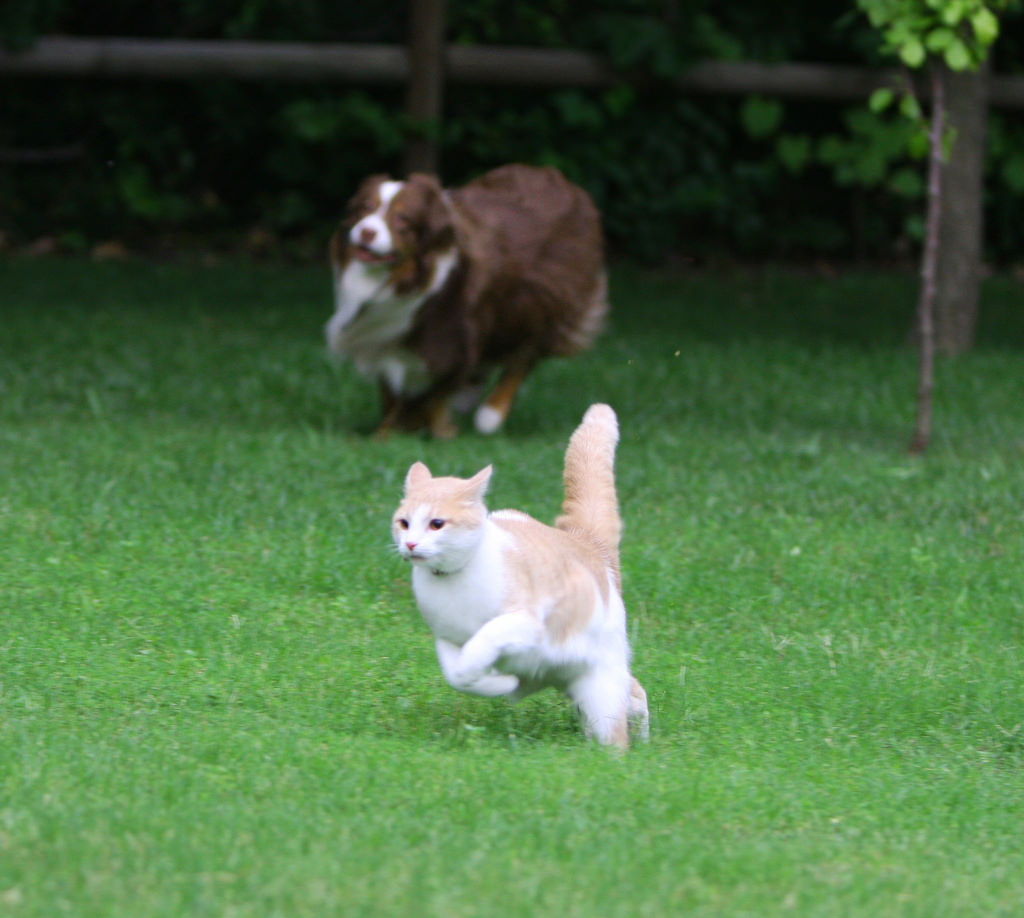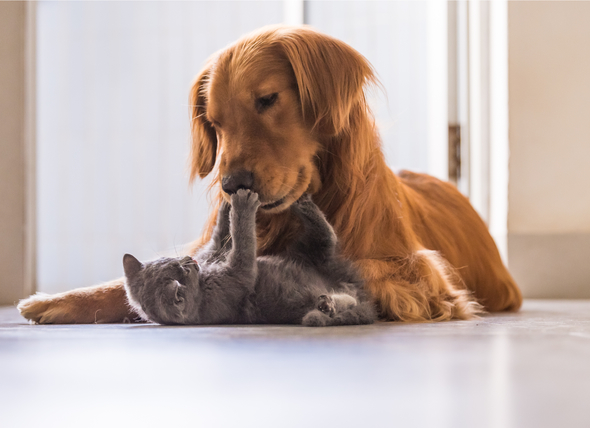Nothing breaks your heart as a pet parent than watching your kitty and pup not get along – specifically when the former is terribly afraid of the latter.
The minute your sweet dog approaches, the cat will either retreat to one of her hiding spots. She can also arch her back as a sign that she’s ready to fight or start clawing and biting the dog.
What’s going on? Why is your cat afraid of dogs? We investigate…
1. Size Differences
First things first, cats are terrified of dogs because canines are much larger and heavier than they are. Imagine a 60-pound German shepherd trying to play with a 15-pound Siamese cat.
Even with the right intentions, the size difference will intimidate any cat to pieces. If something were to happen during the interaction, the dog will have an upper hand over the kitty.
Kitties, like human beings, don’t like being put in a vulnerable position. They like to be in control of their safety at all times. That’s why they are always climbing in high places in a bid to watch over their surroundings. This way they can catch danger before it comes to them.
Hanging with a big dog means being vulnerable and anything can go wrong at any time and they don’t like it.
Granted, most cats are fine being around toy dog breeds like Chihuahuas, Papillions, Fritz breeds, toy Poodles, and Maltese. If socialized early, they can play with and sit next to each other without starting a war.
2. Cat Chasers

While not all dogs are ardent cat chasers, a huge majority of them are. This is especially true for scent hounds including the Afghan hound, the Irish Wolfhound, the Greyhound, the Italian greyhound, the Pharaoh hound, and the Scottish deerhound. These breeds have such a high prey drive and are wired to chase after anything that moves and is smaller than them.
Other high-prey drives breeds include terrier dogs, Shih Tzus, mastiff dogs, border collies, Siberian husky, Samoyed, and Weimaraner.
The good news is that even if you have a dog of any of the above breeds, they can get along with the kitty. This is more of a generalization but you know these things really depend on the individual.
Socialization plays a key role here. You can socialize your English bullmastiff to have a peaceful and fun friendship with your cat and watch them become besties for life.
3. Cats Are Laid Back While Dogs Are Loud
Here’s another reason cats don’t particularly enjoy being near dogs. Unlike dogs who bark, howl, growl, and yap, cats are much quieter. Sure, they meow and purr but these don’t compare to dog noises in the noise meter.
Felines are less active compared to dogs. They spend their free time grooming themselves, scratching the post, snoozing in their cat house, or exploring their environment on high perches.
All these do not require loud barking, running around like crazy, jumping on top of each other, and just being loud—things dogs are known for. Cats can easily get terrified of these sounds.
3. Past Traumatic Experiences
The adage ‘once beaten, twice shy’ is very much true with cats except for them it changes to ‘once beaten forever shy’.
When your poor kitty goes through a bad experience, she will always remember it. Like for instance, if she is ever abused by humans, she will develop an irrational fear for human beings. Yelling, corporal punishment, and being mishandled can have lasting effects on your cat.
The same applies to a bad experience with the dog. If a dog chased your kitty around and threatened her safety once, the feline will develop fear towards all dogs.
Even dogs that don’t mean harm will always be met with unfriendliness from the kitty. The traumatic experience simply stays around for a while.
Luckily, this is reversible. With persistent socialization and training of the cat, she will learn to be around the dog for long periods of time.
Is There Any Hope?

When you are faced with a situation where your kitty is afraid of the dog, you often wonder if it’s too late to do anything.
To prevent the problem from ever occurring in the first place, you needed to socialize the animals right from a tender age. Bending the tree when it’s already grown is a hard task. However, it’s doable for a committed pet parent.
First, you want to re-introduce the pets to each other. This time around, try to do it right.
Keep the dog and cat in separate spots at home at first. You want your kitty to associate the dog with anything but fear.
Rub a piece of cloth on the dog and give it to the kitty to familiarize herself with the scent.
Throw some treats alongside the towel and watch her reaction to it.
If the cat doesn’t show signs of aggression, bring the dog near her but with the dog on a leash and the cat in some sort of a cage. At first, she will try to run but give her time as you give treats until she calms down.
Now let the pets interact with the dogs on a leash the remove the leashes and keep a close eye.
If the cat shows no signs of running, you are successful. If something is off, revisit some of the steps above.
Are Male or Female Cats Better With Dogs?
When choosing dogs and cats to own at home, gender is the least of your concerns.
See, two dogs/cats of the same gender may not get well with each other because of dominance issues. For two males, one feels the other one is a threat to the queens. Each one wants to have the entire space to be king over. Females, on the other hand, mark territories to get the best spots for nurturing their young.
For two pets of different species, there are no clashes when it comes to sexuality. No party feels threatened by the other. As such gender is a non-issue.
What you should worry about is getting your dogs to accept the cats in the first place.
Hopefully, the dog is already exposed to many animals. Conversely, as you shop around, you should get a kitty with good social skills—one that is not too terrified by dogs. You want to introduce the pets carefully. Let them smell each other before they meet physically.
Related Posts:
Closing Thoughts
Cats have all the reasons to be afraid of canines. From chasing them around for fun, throwing their massive sizes around, and barking so loudly, dogs can do a number on kitties. Should you find yourself in a situation where your pets refuse to be on good terms with each other, try the tips suggested here.

Hi! I am Eleanor Price. I started this website after my cat, Louie, almost died from a case of botulism (a type of food poisoning often caused by bacteria that grow on food items). Turned out that my cat’s diet was the problem. I have made it my duty to provide the best information and recommendations about everything cat lovers need to know about their felines’ health and wellbeing. My goal is to find the most informative content on anything feline-related and share it with fellow hardworking kitty lovers.

